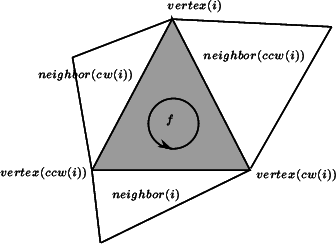|
CGAL 4.9.1 - 2D Triangulation
|
|
CGAL 4.9.1 - 2D Triangulation
|
#include <CGAL/Triangulation_2.h>
Inherited by CGAL::Triangulation_2< Traits, Tds >, and CGAL::Triangulation_2< Weighted_point_mapper_2< Traits >, Tds >.
The class Triangulation_cw_ccw_2 offers two functions int cw(int i) and int ccw(int i) which, given the index of a vertex in a face, compute the index of the next vertex of the same face in clockwise or counterclockwise order.
This works also for neighbor indexes. Thus, for example the neighbor neighbor(cw(i)) of a face f is the neighbor which is next to neighbor(i) turning clockwise around f. The face neighbor(cw(i)) is also the first face encountered after f when turning clockwise around vertex i of f.
Many of the classes in the triangulation package inherit from Triangulation_cw_ccw_2. This is for instance the case for CGAL::Triangulation_2::Face. Thus, for example the neighbor neighbor(cw(i)) of a face f is the neighbor which is next to neighbor(i) turning clockwise around f. The face neighbor(cw(i)) is also the first face encountered after f when turning clockwise around vertex i of f.

Creation | |
| Triangulation_cw_ccw_2 () | |
| default constructor. | |
Operations | |
| int | ccw (const int i) const |
returns the index of the neighbor or vertex that is next to the neighbor or vertex with index i in counterclockwise order around a face. | |
| int | cw (const int i) const |
returns the index of the neighbor or vertex that is next to the neighbor or vertex with index i in counterclockwise order around a face. | |